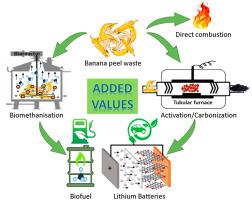Biomass & Bioenergy ( IF 5.8 ) Pub Date : 2021-11-04 , DOI: 10.1016/j.biombioe.2021.106279 Johanna A. Serna-Jiménez 1, 2 , Fernando Luna-Lama 3 , Álvaro Caballero 3 , María de los Ángeles Martín 2 , Arturo F. Chica 2 , José Ángel Siles 2

|
The following different valorisation processes of banana peel waste (BPW) were evaluated: combustion, production of activated carbon/batteries, and biomethanisation. This study showed that the combustion of BPW is an interesting option with a zero-carbon cycle. A mass balance demonstrated a low concentration of sulphurous compounds in the flue gases (0.01%, in volume), but the content of structural nitrogen dioxide was remarkable (0.35%). Additionally, BPW should be pre-dried to increase its lower calorific value (LCV) upto 3000 kcal/kg. In contrast, the mesophilic biomethanisation of BPW led to the generation of renewable methane (182 LCH4/kg VS, volatile solids) and organic digestate, whereas its biodegradability was found to be 68% under the study conditions. The obtention of porous activated carbon was also demonstrated by employing a simple and low-cost method based on chemical activation/carbonisation of BPW with KOH porogen. The banana peel waste carbon (BPW–C) obtained showed low crystallinity, high purity, and Brunauer-Emmett-Teller surface area (SBET) of 264 m2/g. BPW-C was tested as an anode electrode in lithium-ion batteries (LIBs), and a remarkable reversible capacity of 225 mAh/g at 0.2 C after 200 cycles was observed. These results indicate the feasibility of the carbonisation method of BPW to produce a highly demanded product in the current society.
中文翻译:

香蕉皮废料作为不同可再生能源系统的前体材料的价值化
评估了香蕉皮废料 (BPW) 的以下不同增值过程:燃烧、活性炭/电池的生产和生物甲烷化。这项研究表明,BPW 的燃烧是一个有趣的零碳循环选择。质量平衡表明烟气中含硫化合物的浓度较低(0.01%,体积),但结构性二氧化氮的含量显着(0.35%)。此外,BPW 应预先干燥以将其低热值 (LCV) 提高到 3000 kcal/kg。相比之下,BPW 的中温生物甲烷化导致产生可再生甲烷(182 L CH4/kg VS,挥发性固体)和有机消化物,而在研究条件下发现其生物降解性为 68%。通过采用基于 BPW 与 KOH 致孔剂的化学活化/碳化的简单且低成本的方法,也证明了多孔活性炭的获得。获得的香蕉皮废炭 (BPW-C) 显示出低结晶度、高纯度和264 m 2 /g 的Brunauer-Emmett-Teller 表面积 (S BET ) 。BPW-C 作为锂离子电池 (LIBs) 的阳极电极进行了测试,在 200 次循环后观察到在 0.2 C 下具有 225 mAh/g 的显着可逆容量。这些结果表明 BPW 的碳化方法生产当今社会需求量很大的产品的可行性。











































 京公网安备 11010802027423号
京公网安备 11010802027423号